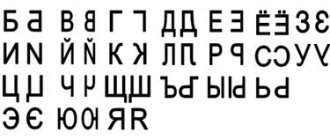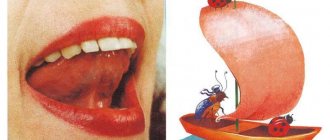Dysarthria is a severe speech disorder, accompanied by a disorder of articulation, phonation, speech breathing, tempo-rhythmic organization and intonation coloring of speech, as a result of which speech loses its articulation and intelligibility. Among children, the prevalence of dysarthria is 3-6%, but in recent years there has been a pronounced upward trend in this speech pathology. In speech therapy, dysarthria is one of the three most common forms of oral speech disorders, second only to dyslalia in frequency and ahead of alalia. Since the pathogenesis of dysarthria is based on organic lesions of the central and peripheral nervous system, this speech disorder is also studied by specialists in the field of neurology and psychiatry.
Symptoms of the disease
The symptoms of pseudobulbar dysarthria depend on the severity, of which there are only four:
- 1st degree – there are no pronounced speech defects, which can be identified by a speech therapist.
- 2nd degree – the child’s speech is understandable, but some speech disorders are noticeable.
- 3rd degree – speech is incomprehensible to people around, including loved ones.
- 4th degree – the patient’s speech is not completely understandable.
The general symptoms of this form of dysarthria have some components:
- distorted syllables, sounds;
- hypertonicity of the facial muscles;
- limited mobility of the tongue and lips;
- increased salivation;
- weak quiet voice;
- arrhythmia of breathing.
A diagnosis of “pseudobulbar dysarthria” can only be made by a speech therapist or neurologist based on certain research results.
Cerebellar dysarthria
Cerebellar dysarthria is characterized by disorders associated with the pronunciation side of speech. These disorders are caused by damage to the cerebellum. This form of dysarthria is characterized by the following manifestations:
- loss of fluency of speech;
- disturbance of the rhythm of speech;
- loss of expressiveness;
- slowness and intermittency of speech.
This speech disorder is observed against the background of impaired coordination of movements of various muscles, which is caused by pathology of the cerebellum. Correction of cerebellar dysarthria involves etiopathogenetic treatment of the underlying pathology, drug support, as well as general rehabilitation measures: physical therapy, massage, work with a psychologist, classes with a speech therapist).
Causes of speech impairment
Speech disorders occur when the pathways between the bulbar nerves and the cerebral cortex are damaged. This can occur for a number of reasons:
- Cerebrovascular disorders. These are strokes, cerebral ischemia, cerebral atherosclerosis. These diseases often lead to the development of pseudobulbar disorders, leading to disorders of the speech apparatus.
- Head injury. This reason is most common for children over one year of age.
- Perinatal pathology. This group includes fetal hypoxia, intrauterine infections, and birth trauma. As a result of these processes, functional corticobulbar disorders occur.
- Neuroinfections.
For all these reasons, with pseudobulbar dysarthria, the structure of the speech defect suffers and is disrupted.
Dysarthria
Dysarthria is a deviation in which there is difficulty in pronouncing individual sounds or words. The defect develops due to a violation of the innervation of the muscles of the larynx or due to damage to the central nervous system.
Types of dysarthia
- pseudobulbar dysarthria
- speech dysarthria
- erased dysarthria
- bulbar dysarthria
- cerebellar dysarthria
- cortical dysarthria
- phonemic dysarthria
- motor dysarthria
- extrapyramidal dysarthria
With pathology, a person distorts speech, there is tension in the facial muscles, shortened exhalation and a weak tone of voice. Emotional people stop leading a social lifestyle and withdraw into themselves.
The causes of dysarthria are previous complicated pregnancy, various injuries, organic brain damage, infections of the central uneven system. They cause persistent disturbances, as a result of which deviation develops.
Severity of dysarthria:
- I – detected only during examination by a speech therapist, there are no pronounced deviations;
- II – disturbances are observed, but speech intelligibility is preserved;
- III – speech can only be understood by close relatives, gestures are used;
- IV – the patient speaks with difficulty, it is almost impossible to understand him.
Pseudobulbar dysarthria
Pseudobulbar dysarthria is a violation of the pronunciation of individual sounds and words as a result of organic brain damage, infection or the presence of a tumor suffered during fetal development or in infancy. A characteristic pseudobulbar palsy develops with damage to a number of cranial nerves. Additionally, neurological symptoms are added.
If pseudobulbar dysarthria is present, the patient is treated by a neurologist and works with a speech pathologist. The program for speech restoration is selected depending on the severity of the condition.
Speech dysarthria
This form of dysarthria occurs with the presence of pronounced speech impairments, often accompanied by pronounced difficulties in pronouncing certain sounds. At the same time, the spelling and perception of words is preserved, the child learns normally. The cause may be both organic damage to the central nervous system and socio-psychological factors.
Treatment of speech dysarthria largely depends on the qualifications of the speech therapist-defectologist - the program is selected individually depending on the severity of speech disorders. Various trainings are conducted in groups and homework is assigned.
Erased dysarthria
Erased dysarthria occurs with mild disorders; its cause is minor disturbances in the innervation of the vocal muscles. Both the pronunciation of certain sounds and voice intonation, timbre, tone and expressiveness suffer. There is unclear spoken speech and distortion of some sounds.
The clinical picture of erased dysarthria may differ in each patient and manifest itself individually. The corrective program is selected taking into account the severity of the disorders and the presence of neurological disorders. Patients are observed by a speech pathologist and a neurologist.
Bulbar dysarthria
This form of dysarthria is characterized by damage to the medulla oblongata, resulting in neurological symptoms. The most obvious sign is paralysis of the muscles of the pharynx and larynx, as a result of which the reproduction of certain sounds is impaired. Depending on the degree of damage, speech may be partially preserved or lost completely.
With bulbar dysarthria, the swallowing reflex is impaired, and part of the cranial nerves is affected. An accurate diagnosis will be made by a neurologist, and the same specialist observes the patient together with a speech pathologist.
Cerebellar dysarthria
Cerebellar dysarthria is a severe disorder that is accompanied by damage to the cerebellum. This department is responsible for coordinating movements, so balance disorders, problems with walking and self-care may occur. There are disturbances in intonation, speech is “chopped”, the patient may shout out certain sounds.
Cerebellar dysarthria is rare in children; the most common cause is brain injury. A mandatory consultation with a neurologist is required; a specialist will conduct a clinical examination and determine the severity of the condition.
Cortical dysarthria
In the cortical form of dysarthria, disturbances are noted at the level of the cerebral cortex, in particular the speech apparatus. Difficulties arise with the pronunciation of complex sounds, with switching from one word to another. The patient tries to replace it with a more familiar one or misses it. Sounds may be distorted, causing speech to become unclear and unintelligible.
Before treatment of cortical dysarthria, a consultation and examination is carried out under the supervision of a neurologist, the degree of damage to the nervous system is determined. Comprehensive treatment is prescribed, including training to restore normal speech.
Phonemic dysarthria
Phonemic dysarthria is characterized by a violation of the perception of certain sounds (phonemes) by ear, which is why their pronunciation suffers. Most often found in children. Typically, difficulties arise with complex words in which individual sounds cannot be distinguished. Compensatory, they can change into similar ones, become distorted, and the patient can miss these words. As a result, the quality of speech deteriorates and it becomes incomprehensible.
To correct phonemic dysarthria, work is carried out with a speech therapist-defectologist; consultation with a neurologist and psychologist may be required, depending on the cause.
Motor dysarthria
Motor dysarthria is often accompanied by neurological disorders, in which, in addition to sound pronunciation disorders, motor skills also suffer. This form requires clarification and mandatory examination by a neurologist. Often its cause is organic brain damage or the individual mental development of the child. In the latter case, it goes away over time, but if you contact a specialist in a timely manner, the chances of a favorable outcome are higher.
If motor dysarthria is suspected, urgent consultation with a specialist is required. The diagnosis is made after a clinical examination and special tests.
Extrapyramidal dysarthria
This form of dysarthria is accompanied by extrapyramidal disorders with changes in muscle tone and a number of movement disorders. Coordination and precision of movements are impaired even when performing everyday activities. A neurologist can make an accurate diagnosis.
With extrapyramidal dysarthria, the reproduction of individual sounds or words is impaired with accompanying neurological symptoms, including seizures. Mental disorders may occur; in this condition, a consultation with a psychiatrist is prescribed. If this form of pathology is suspected, urgent examination and treatment is required.
We offer effective treatment for dysarthria - we work even with severe patients, we provide treatment without medications or hypnosis. Make an appointment with our center at a convenient time using the contacts provided on the website.
Forms of pseudobulbar dysarthria
There are three forms of this type of dysarthria:
- spastic (spasmodic);
- paretic;
- mixed (that is, spastic-paratic).
Each of these forms has its own symptoms and treatment features.
Spastic form of pseudobulbar dysarthria
This form of pseudobulbar dysarthria is characterized by tension of the respiratory muscles or hyperkinesia of the larynx, spastic paresis of the lingual muscle, tension of the labial muscles and impaired tone of the palate.
Such manifestations make speech more monotonous, with a nasal tone. It is difficult for a child to maintain articulatory postures, there are difficulties in switching them, and the breathing process may take a long time, which leads to problems in voice formation (articulation). With pseudobulbar dysarthria, the following characteristic phenomena are observed:
- silent articulation;
- there is no prolonged rest of the speech muscles;
- spasms of the labial muscles;
- tension when smiling;
- limited tongue movements;
- disturbances in sucking and swallowing movements are observed;
Often in children with this disorder, the first cry is absent, and breathing is pronouncedly weak and arrhythmic, there is a weak short exhalation, and speech occurs while inhaling. This species is also characterized by the presence of speech phonations, a weak, quiet voice, the rate of speech is fast, but its rhythm is not maintained. In other words, someone who has a spastic form of pseudobulbar dysarthria speaks from spasm to spasm, which leads to the use of short phrases with poor intelligibility, depending on the strength of the voice. At the same time, the meaning of what was said does not suffer.
Paretic form of pseudobulbar dysarthria
This form is observed with hypotonia of the speech and skeletal muscles. The child has pareticity of the tongue, lips, and palate. There is difficulty in switching articulatory postures, asynchrony in breathing and articulatory movements. Often such a child may have increased salivation (salivation).
The inhalation during conversation is short and inadequate, and the exhalation is also weak. The voice itself is loud, ringing, but quickly fading. Speech in this case has a nasal pronunciation, weak and quiet. Some isolated sounds are completely preserved, but in the speech stream they are blurred. Eating is at a disturbed pace and there are difficulties in coordinating chewing movements.
Mixed form
This form is the most common. In the scientific literature it is called spastic-paretic syndrome. With it, there is hypertonicity of one muscle group, for example, the muscles of the lips and cheeks, while the tongue has reduced tone.
Forecast and prevention of dysarthria
Only early, systematic speech therapy work to correct dysarthria can give positive results. A major role in the success of correctional pedagogical intervention is played by the therapy of the underlying disease, the diligence of the dysarthric patient himself and his close circle.
Under these conditions, one can count on almost complete normalization of speech function in the case of erased dysarthria. Having mastered the skills of correct speech, such children can successfully study in a comprehensive school, and receive the necessary speech therapy help in clinics or at school speech centers.
In severe forms of dysarthria, only improvement in speech function is possible. The continuity of various types of speech therapy institutions is important for the socialization and education of children with dysarthria: kindergartens and schools for children with severe speech disorders, speech departments of psychoneurological hospitals; friendly work of a speech therapist, neurologist, psychoneurologist, massage therapist, and physical therapy specialist.
Medical and pedagogical work to prevent dysarthria in children with perinatal brain damage should begin from the first months of life. Prevention of dysarthria in early childhood and adulthood involves preventing neuroinfections, brain injuries, and toxic effects.
Diagnosis of pseudobulbar dysarthria
The patient should be managed by a speech therapist, neurologist and other specialized medical specialists. For accurate diagnosis, the following research methods are used:
- speech therapy speech study;
- electroencephalography;
- electromyography;
- MRI of the head.
In some cases, a study of cerebrospinal fluid by lumbar puncture may be prescribed. This analysis identifies neuroinfectious causes. A neurologist should participate in the diagnosis. They must undergo an examination, special tests, and a study of the child’s motor skills and facial expressions. These methods make it possible to assess the degree, type, and causes of the disorder, and also, based on the data obtained, formulate an effective treatment program.
Erased dysarthria in children
Erased dysarthria, as mentioned earlier, is the first degree of severity of dysarthria. With this disorder, mild disorders of the phonetic and prosodic (voice strength, tempo, rhythm, intonation) components of speech are observed. These disorders are caused by insufficient supply (innervation) of the articulatory organs with nerve cells.
The following characteristics of this speech defect are noted:
- unclear articulation;
- distortion of sounds of several phonetic groups;
- complexity of automation;
- unimpressive speech.
Correction of erased speech dysarthria involves the use of articulation, breathing and finger exercises, as well as speech therapy massage. Particular emphasis is placed on automating evoked sounds and normalizing prosody. Classes with a speech therapist are carried out in parallel with treatment by a neurologist. When treating, it is necessary to take into account the characteristics of dysarthria - the severity of the pathology, its type, as well as the level of speech development of the child.
Treatment of pseudobulbar dysarthria
Corrective work is based on speech therapy sessions and exercises. They are carried out under the supervision of a specialist and are aimed at developing fine and speech motor skills. In some cases, drug treatment may be used. General correction of this form of dysarthria consists of:
- physiotherapy;
- therapeutic physical culture;
- taking baths;
- reflexology and others.
Nootropics are used for drug treatment. It is important to understand that early diagnosis is extremely important in this matter. All therapeutic measures of the correction program should be prescribed exclusively by a specialist; self-medication can be dangerous.
For correction, etiopathogenetic treatment is used. It eliminates the etiological factors of speech development. If dysarthria is caused by neuroinfections, it is necessary to prescribe antiviral and antibacterial therapy. Treatment methods depend on the causes of this speech disorder.
An important part is special speech therapy classes. For hypertonicity, speech therapy massage, breathing exercises and other exercises can be used. This part of the correction is aimed at obtaining fluency of speech, its emotionality and expressiveness.
Causes of dysarthria
Most often (in 65-85% of cases) dysarthria accompanies cerebral palsy and has the same causes. In this case, organic damage to the central nervous system occurs in the prenatal, birth or early periods of child development (usually up to 2 years). The most common perinatal factors of dysarthria are toxicosis of pregnancy, fetal hypoxia, Rhesus conflict, chronic somatic diseases of the mother, pathological course of labor, birth injuries, at birth, kernicterus of newborns, prematurity, etc. The severity of dysarthria is closely related to the severity of motor disorders in cerebral palsy : Thus, with double hemiplegia, dysarthria or anarthria is detected in almost all children.
In early childhood, damage to the central nervous system and dysarthria in a child can develop after suffering neuroinfections (meningitis, encephalitis), purulent otitis media, hydrocephalus, traumatic brain injury, severe intoxication.
The occurrence of dysarthria in adults is usually associated with a stroke, head injury, neurosurgery, and brain tumors. Dysarthria can also occur in patients with multiple sclerosis, amyotrophic lateral sclerosis, syringobulbia, Parkinson's disease, myotonia, myasthenia, cerebral atherosclerosis, neurosyphilis, oligophrenia.
Difference between bulbar dysarthria and pseudobulbar dysarthria table
The main differences between bulbar dysarthria and pseudobulbar dysarthria are as follows:
- They differ in the characteristics of paralysis of the speech muscles. With the bulbar type, peripheral paresis is observed, and with pseudobulbar paresis it is central.
- With bulbar, voluntary and involuntary movements of speech motor skills are disrupted. With pseudobulbar, only voluntary sounds are affected.
- With bulbar dysarthria, diffuse articulatory motor skills are affected, and in the second type, a selective nature of the violation of articulatory movements is observed.
There are also differences in sound pronunciation. The bulbar type makes the pronunciation of vowels neutral.
Cortical dysarthria
Cortical dysarthria
manifests itself as a motor speech disorder of various pathogenesis. There are several types of cortical dysarthria:
1. Dysarthria caused by unilateral, but more often bilateral, lesions of the lower part of the anterior central gyrus
. Selective central damage to the muscles of the articulatory apparatus most often affects the tongue, which leads to a decrease in the volume of fine, targeted movements. Usually the tip of the tongue is affected, so the pronunciation of the anterior lingual sounds (Ш, Ж, Р, Л) is impaired; in severe forms, these sounds are absent in speech, in the lungs they are replaced by soft or hard whistling or anterior lingual sounds (instead of T – Ть, instead of Д-Дь) . Difficulty arises in setting L-L, and the tempo and fluency of speech may be disrupted.
2. Dysarthria is associated with bilateral damage to the cortex of the dominant hemisphere
in the lower postcentral parts of the cerebral cortex. It is difficult to pronounce sibilants and affricates. Articulation disorders are variable and ambiguous. In some cases the child speaks, but in others he cannot speak, because it takes a long time to find the right way of life, so the pace and fluency of speech slows down. There is insufficient sensitivity of the face. The child finds it difficult to pinpoint the touch.
3. Dysarthria is caused by unilateral damage to the cortex of the dominant hemisphere
in the lower parts of the premotor areas. There is a lack of dynamic praxis, an inability to switch from one articulatory posture to another. The production of affricates is difficult (they break down into their component parts). Replacing fricative sounds with stop sounds (Z to D, S to T). Omissions of sounds when consonants coincide, selective deafening of voiced stop consonants. Speech is slow and unnatural.
Up
Possible complications
Speech impairments make it difficult, and in some cases completely eliminate, communication with other people. Understanding the presence of a problem with articulation, the inability to convey information to others negatively affects overall mental health, and can also lead to neurotic disorders such as neurasthenia, depression and others. With dysarthria, difficulty eating is often observed. A person often chokes on food and water, which can lead to asphyxia or aspiration pneumonia.
Children suffering from pseudobulbar dysarthria often experience general speech underdevelopment (GSD), which in turn is dangerous due to dyslexia and dysgraphia. Children with a mild form may encounter problems at school (communicating with teachers and classmates). Children with moderate and severe forms are trained in specialized schools. If correctional work is not carried out with the child on time, there is a likely risk of developing intellectual disability and general mental retardation.
Diagnostic and treatment methods
The Clinical Institute of the Brain specializes in the diagnosis and treatment of speech activity disorders, including those caused by disorders of nervous activity. An important stage is an examination by a speech therapist, during which even hidden forms of dysarthria are identified. The procedure consists of several stages, during which the correctness of breathing and uniformity of speech, reproduction of individual sounds and conscious word combinations are assessed. The patient is also asked to undergo certain tests that reveal the degree of development of written speech. This can be either rewriting fragments of text or writing from dictation, as well as awareness of written speech.
Additional diagnostic stages are aimed at identifying the area of the nervous system in which the lesion is located. This is possible thanks to specific techniques:
- electrophysiological studies, including electroencephalography and assessment of facial muscle activity;
- study of the brain using transcranial magnetic radiation;
- MRI of the brain.
Treatment of dysarthria is a long process that is completely under the control of doctors at the Clinical Brain Institute. The therapy is aimed at strengthening neural connections and stimulating the conduction of nerve impulses, as well as improving speech activity. The main condition for positive dynamics is the work of a competent speech therapist and neurologist, as well as systematic training. A good therapeutic effect is achieved through physiotherapy, physical therapy, and special massage techniques (reflex, acupressure). In addition, spa treatment is recommended, including those aimed at improving the patient’s communication abilities. Spending time with animals is beneficial - most experts recommend hippotherapy. The prognosis depends on the stage of the disease, as well as on the timeliness of its diagnosis and systematic treatment. With mild dysarthria, complete restoration of speech function is possible, with severe dysarthria, its partial improvement.








